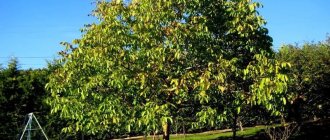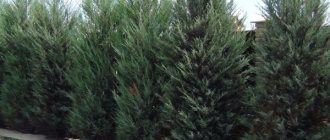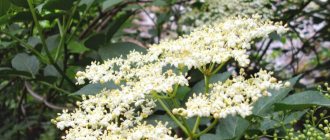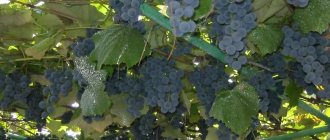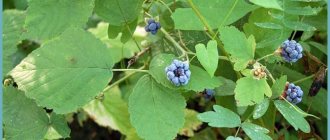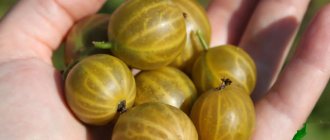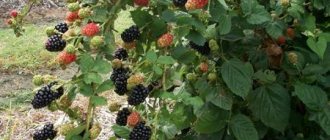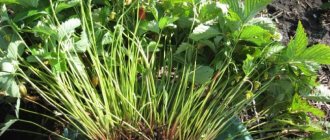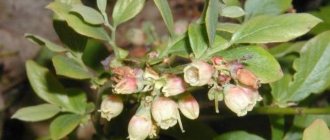Viburnum bushes undoubtedly greatly decorate a summer cottage. Large white flower caps in spring and red berries in autumn look great against the backdrop of rich green or reddish carved leaves. In addition, this beauty does not require special care, the seedlings take root easily, and the berries and branches have culinary and medicinal uses.
Viburnum bushes - description
Viburnum is a deciduous shrub or small tree. Viburnum leaves are opposite, sometimes whorled, deciduous, simple, lobed, palmately lobed or entire, serrated or entire, petiolate. The apical simple or complex umbellate or umbellate-corymbose inflorescences consist of pink or white flowers. Flowering viburnum begins in late May or early June. The fruit is usually an edible drupe of red or blue-black color. The lifespan of viburnum is on average 50-60 years.
Today, viburnum is gaining popularity among amateur gardeners and is grown in home gardens along with such fruit trees as apple, pear, plum, cherry and sweet cherry. We offer you a detailed story about how to plant viburnum in your garden, how to care for viburnum from the moment of planting until the end of its life cycle, how to propagate viburnum, how to feed viburnum to ensure a stable harvest of its most valuable berries, how to prune viburnum to prolong its lifespan - we have collected and systematized all this information in our article so that it is easy and convenient for you to use it.
Planting viburnum
When to plant viburnum.
Planting and caring for viburnum does not involve any difficulties. Viburnum grows well on neutral and slightly acidic soils (pH 5.5-6.5), but peat, podzolic and sandy soils are not suitable for it. The depth of groundwater in the area where viburnum grows is desirable to be at least 1 m. In order for your viburnum to grow for a long time and be healthy, create conditions for it that are close to natural.
Viburnum loves good light, but grows best in partial shade. Some experts even claim that viburnum grown in shady places is less susceptible to attack by pests.
Viburnum is planted both in spring and autumn. Before planting, the area is dug up, freeing the soil from weeds. There is no need to add organic fertilizers to fertile soil, but if the soil is poor, fertilizers are applied directly into the hole during planting.
Planting viburnum in spring.
So, in the spring, before the leaves bloom, dig a hole measuring 50x50x50 in the area. If you are planting more than one bush, then place the holes at a distance of 2.5-3.5 m from each other. Pour 2/3 of a thoroughly mixed soil mixture into the hole, consisting of the top layer of soil taken out of the hole, 1 bucket of humus or peat and 2 cups of Nitrophoska, pour out 4 buckets of water and leave for several days. After about a week, pour the remaining mixture into a heap into the hole so that it rises 10-12 cm above the surface, place the roots of a three-year-old seedling on the mound, straighten them, fill the hole with the remaining mixture, compact the surface of the area around the seedling, water it generously and mulch the tree trunk circle with compost , peat or humus. Try to place the viburnum seedlings so that their root collar is 5-6 cm underground.
Planting viburnum in autumn.
Autumn planting of viburnum is no different from spring. Viburnum is planted in the time period between leaf fall and the first frost.
Viburnum: propagation, planting and care
Many people immediately associate the word “viburnum” with the definition “red”.
But nowadays, viburnum has so many varieties that the color of the berries can even be black. Viburnum is loved by many for its beauty both in spring and autumn. Viburnum (Viburnum)
At the beginning of summer, it pleases us with beautiful umbrella-shaped or spherical inflorescences with a diameter of about 15 cm with snow-white or pale pink flowers. And in the fall, the carved viburnum foliage becomes especially beautiful, glowing in numerous shades of orange and crimson red with scarlet berries hanging on the branches.
The fruits can hang on the tree until snow falls, providing a particularly tasty treat for birds.
The fruits can hang on the tree until the snow falls. But these berries are also valuable for people, because they are very useful and even medicinal, and like the flowers and bark of viburnum, they are used in traditional medicine recipes. There are also sterile, decorative varieties of viburnum, valuable for their beautiful foliage, bush shape, and lush inflorescences.
Viburnum care
Caring for viburnum in spring.
At the end of March or beginning of April, last year's foliage is removed from under the bushes and the soil in the tree trunk is loosened. A little later, viburnum bushes are treated with fungicides against pathogens and pests that have overwintered in the upper layers of the soil or in cracks of trunks and branches. You can treat the plant with a seven percent urea solution - both as a top dressing and as a preventive measure against diseases and pests, but before spraying the viburnum, make sure that the buds on it are not yet opening, otherwise you can burn them.
Towards mid-May, viburnum is fed with potassium fertilizer, and after flowering, complex fertilizer is applied to the soil around the tree trunk.
Caring for viburnum in summer.
After flowering, viburnum is fed with complex fertilizer if necessary. Regularly inspect the plant for harmful insects and promptly treat viburnum for diseases. At the beginning of June, you can treat the viburnum with an infusion of tobacco, or you can periodically spray the bushes with an infusion of potato tops, onion peels or garlic from June until harvest.
Otherwise, caring for viburnum in the summer consists of regular watering and loosening the soil in the tree trunk circle while simultaneously destroying emerging weeds.
Caring for viburnum in autumn.
After the viburnum sheds its leaves, remove it along with the old mulch, carry out preventive treatment of the viburnum against pests and pathogens that have spent the winter in the bark and soil, add liquid fertilizer to the soil or mulch the tree trunk circles again with rotted organic matter.
When stable frosts occur, remove the clusters of berries from the bushes and place them in storage.
Processing viburnum.
Viburnum, just like other garden trees and shrubs, can suffer from harmful insects and various kinds of diseases, so it is very advisable to protect it from them by preventive treatment in spring and autumn. Insecticides are used to kill insects, and fungicide sprays are effective against fungal diseases. Unfortunately, it will not be possible to cure viburnum from viral and bacterial diseases, but since their pathogens are most often carried by pests from the insect world, timely destruction of pests or their larvae will help avoid infection.
Watering viburnum.
Growing viburnum is difficult without weekly watering, especially when it is hot and dry. Water consumption per watering is 3-4 buckets per fruit-bearing bush. A young shrub does not require much moisture, but the frequency of watering should remain constant. A rainy summer certainly makes adjustments, but you must remember that viburnum loves moisture, so do not leave it without water for a long time.
Fertilizing viburnum.
Since you have to water viburnum often, it is advisable to apply fertilizer in dry form - scatter it around the tree trunk before watering. The first fertilizing is applied in the spring, when the leaves begin to bloom: 2 tablespoons of urea are scattered under each viburnum bush (this is if you did not spray the viburnum with urea on the dormant buds).
It is advisable to apply the second fertilizer, potash, before flowering: under each bush, scatter a half-liter jar of wood ash or 2 tablespoons of potassium sulfate.
Viburnum will need a third feeding after flowering: 2 tablespoons of Nitroammofoska are scattered under each bush.
The last feeding is only needed if you do not mulch the viburnum tree trunk with organic matter for the winter, and it consists of two buckets of a solution of the following composition: 2 tablespoons of potassium sulfate and 2 tablespoons of superphosphate, dissolved in 10 liters of water.
Pruning viburnum
When to prune viburnum.
Like other garden trees and shrubs, it is better to prune viburnum in the spring, before the sap begins to flow. You can cut it in the fall, after the leaves fall, but since it is difficult to know for sure when the frosts will strike, it is better to carry out serious pruning (rejuvenating or formative) in the spring, and in the fall it is worth pruning the viburnum only for sanitary purposes.
Pruning viburnum in spring.
In nature, viburnum grows as a tree or in the form of a bush, so it is formed as a bush or tree. In the spring, before the sap begins to flow, they carry out sanitary and then formative pruning of the viburnum: if you want the viburnum to grow as a tree, leave one vertical branch, cut the rest into a ring, and remove the buds in the lower part of the stem, where the trunk is planned. The trunk takes 2-3 years to grow, and when it reaches a height of 1.5-2 m, the growth point is pinched to stimulate branching. All this time you will have to remove root shoots, otherwise you will form a bush. Keep the trunk clean by removing any side shoots that form.
Whether you form a tree or allow the viburnum to grow as a bush, you need to prune the plant in any case, because with age its crown will thicken and grow, and it will become increasingly difficult for you to pick berries from it, and the quality of the fruit will begin to deteriorate over time, and the quantity will decrease. Remove competing branches and shoots, as well as those growing inside the bush or in the wrong direction. When the time comes to rejuvenate the bush, cut off a third of the old branches, and leave the most developed shoots from the basal shoots, which will eventually replace the old branches removed. The next year, replace another third of the old branches, and the third year, replace the last third.
Rejuvenating pruning of viburnum, formed like a tree, is carried out according to the same scheme as similar pruning of fruit trees.
Pruning viburnum in autumn.
After the end of leaf fall, when the viburnum has fallen into a dormant state, it is sanitary pruned - broken, dry branches and shoots affected by disease or pests are removed. Sections thicker than 7 mm are treated with garden varnish. Choose a dry, warm day for this procedure.
Where is the best place to plant viburnum?
Viburnum is one of those perennials that feels great in partial shade. Bright areas exposed to the sun during the day are best left for other, more sun-loving crops. For viburnum, too much sun is even harmful, but in partial shade the bush will always be covered with lush green foliage.
Another advantage of viburnum is that over time the crown of the bush grows greatly. Lush, dense bushes will cover unsightly areas in the form of an old fence or outbuildings.
As for the soil, viburnum prefers and grows best in moist nutrient soils with an acidity of about 5.5 pH.
Viburnum propagation
How to propagate viburnum.
Viburnum is propagated by seeds and vegetatively - by cuttings, horizontal and vertical layering and root shoots. Seed propagation is difficult because the seeds germinate within two years. The simplest and least labor-intensive way to propagate viburnum is by vertical layering.
Propagation of viburnum by seeds.
In order to speed up the germination of viburnum seeds, they need to be subjected to pre-sowing treatment. Freshly collected seeds are placed in nylon stockings with wet sawdust and stored at room temperature for two months, and when they begin to germinate, they are placed in the bottom drawer of the refrigerator for a month, after which they are sown to a depth of 3-4 cm in boxes and wait for germination. In the spring, after the return frosts have passed, the seedlings are planted in open ground, watered abundantly and shaded from direct sunlight for the first time.
Propagation of viburnum by vertical layering.
In the fall, the lower branches of young plants on viburnum are shortened, leaving only 2-4 buds on them, and the stem is spud high. When in the spring the shoots from these buds grow 8-10 cm, they are spud up again to a height of 4-5 cm. When the shoots stretch to 20-30 cm, they are dug up, tied at the base with copper wire and again spud up to a third of the height. After a couple of weeks, another hilling is carried out. By autumn, the shoots are dug up, separated and transplanted to a permanent place.
Propagation of viburnum by cuttings.
Green cuttings take root best, and although cutting viburnum is not an easy process, in some cases it is the only possible way to propagate viburnum. Viburnum cuttings are harvested during the flowering period - in June or early July, when they spring back when bent and do not break. For cuttings you need a middle part of the shoot 10-12 cm long, on which there will be 2-3 nodes. The lower cut should be oblique, the upper leaves should be shortened by half, and the lower ones should be removed.
Dust the lower sections of the cuttings with Kornevin or hold them for several 10-12 hours in a Heteroauxin solution, then plant the cuttings in a substrate consisting of equal parts of river sand and peat. The planting should be inclined, the cuttings are buried 1-2 cm into the substrate, maintaining a distance of 4-5 cm between specimens. After planting, the cuttings are covered with a transparent dome and kept at an air temperature of 27-30 ºC and a humidity of about 90%, moistening the cuttings 3-4 times a day with water from a spray bottle. After three weeks, the cuttings take root, and the dome begins to be removed for a while, accustoming the cuttings to a normal environment. When they get used to it, the cap is removed completely. The cuttings spend the winter indoors, and in the spring, after two weeks of hardening, they are planted in open ground according to the 50x15 pattern and grown. When the seedlings grow enough, they are transplanted to a permanent place.
Propagation of viburnum by horizontal layering.
In the spring, a two- to three-year-old branch is cut off, leaving a part with 2-4 buds, and a year later, next spring, the regrown one-year-old shoot is shortened by one fifth, bent to the ground, placed in a groove 5-6 cm deep, secured with hooks, but not buried , but wait until shoots develop from the buds and reach a height of 10-15 cm, and only after that they fill the furrow with a mixture of peat and humus so that the tops of the branches remain on the surface. During the summer, growing shoots are hilled 2-3 times. In the fall, the branched viburnum branch is cut off from the mother bush, and the rooted shoots are separated from the layer and planted in a permanent place.
Reproduction of viburnum by basal shoots.
This is a quick and easy solution to the problem of reproduction. At the end of spring or early summer, the basal shoots, which have reached a height of 20 cm, are spud to a height of 7-8 cm, having previously pulled them over at the base with soft wire. During the summer, 2-3 hillings of the shoots are carried out, eventually bringing the height of the mound to 20 cm, and next spring they are separated from the bush and replanted.
Formation of viburnum in the form of a tree
Viburnum produces root suckers, so it is more difficult to form it into a tree than, for example, an apple or pear tree.
- Allow the young seedling to take root well. Let it grow for two years without formative pruning.
- In the third year, from all available shoots, select the strongest and straightest one, and remove the rest.
- Over the next 2-3 years, grow this shoot. Cut all the lower side branches to the height of the trunk - 30–40 cm, leave the upper ones to select skeletal branches from them.
- When the trunk grows to one and a half meters, pinch the growth point.
- From the side branches of the upper tier, form a crown that is convenient for you. The main thing is that it is not thickened - apply all the rules of thinning pruning.
The arrows in the diagram indicate the view before and after trimming
Remember to regularly remove all root growth. According to numerous reviews from gardeners, the viburnum tree is fragile, the trunk is not too thick, is often twisted, and is broken by strong winds. A support will help solve this problem, but a stake or pipe standing nearby can spoil the beauty of the viburnum. In addition, such a tree is less productive compared to a bush. The main advantage of this method is originality. But there are varieties that do not sprout, they themselves grow into one trunk, in which case formation by a tree is the only option.
Photo gallery: viburnum growing as a tree
Viburnum can be formed into one trunk
The lush tree-like viburnum looks very beautiful in winter. Viburnum grows up to 5 meters in height
It's time for viburnum to show off its beauty - it's winter
Viburnum diseases
Viburnum in the garden can be subject to troubles in the form of diseases and harmful insects. Diseases and pests of viburnum are not very numerous, and it is not so difficult to cope with them, but it is still better to prevent the occurrence of a problem than to deal with it later. Among the diseases that affect viburnum more often than others:
Powdery mildew is a fungal disease, the symptoms of which look like a whitish coating on the leaves of the plant, with drops of liquid, which gradually turns brown. The infection rises from the bottom of the plant upward. In a diseased plant, the inflorescences do not form ovaries, and the viburnum does not bear fruit. The winter hardiness of the plant decreases. Decorative species are losing their attractiveness.
Control measures. A good effect is achieved by treating viburnum with a solution of 50 g of colloidal sulfur in 10 liters of water or with fungicides such as Skor, Topsin, Tiovit Jet, Topaz, Quadris, Bayleton and other preparations of similar action;
Frost burn is a disease caused not by infection, but by exposure to low temperatures. This causes the bark to crack, the wood to become exposed and die. On the side shoots of frostbitten branches, the leaves are pale, chlorotic, they turn brown and dry quickly. By mid-summer the entire bush may dry out.
Control measures. Severely damaged stems are cut out at the beginning of spring, and those that are slightly damaged are covered with liquid clay in places of damage;
Ascochyta spotting of viburnum - angular or rounded gray spots with a purple or dark brown border appear on diseased leaves. At the site of the spots, the tissue dies, the fruiting bodies of the fungus form on it, it cracks and falls out.
Control measures. Fallen leaves affected by the disease are collected and burned in the fall. In the spring, at the beginning of sap flow, viburnum is treated with copper oxychloride or Bordeaux mixture.
Gray rot - in cold and rainy summers, large brown spots of unclear outlines appear on the leaves of the viburnum, which grow quickly, and the tissue in the middle dries and cracks. Berries affected by rot become brown, and the mycelium grows through them.
Control measures. In autumn, be sure to collect and burn fallen leaves and berries. To stop the spreading disease, treatment with Vectra is carried out.
Fruit rot - this disease causes the flowers, leaves, young shoots and fruits of viburnum to dry out. The first sign is small, dense, gray pads, which turn black and dry out as the disease progresses.
Control measures. Mummified berries must be removed from the plant and from under the bush. When the first signs of disease are detected, viburnum is treated with Bordeaux mixture or copper oxychloride.
How to plant viburnum: propagation methods, diseases and pests, plant types
Viburnum is a shrub or tree of the Asteraceae family. There are more than 150 species of this plant. Viburnum can be found in Russia, Europe, America and even on the island of Madagascar. The shrub produces edible, healthy fruits in the form of berries. In central Russia, viburnum is grown. It begins to bloom at the end of May. The leaves of the plant are small, opposite, the berries are red with a bitter aftertaste. If you properly care for viburnum, it will look good and bear fruit for 50 years. The plant is valued for its vitamin-rich fruits. At the dacha it is placed next to a pear, cherry, and apple tree.
The most popular plant varieties among gardeners are presented in the table:
This variety is the most common. The plant reaches a height of 4 m. Common viburnum is distinguished by large bright green leaves. The plant produces juicy berries. Depending on the variety, they can be round or elliptical. There is a small bone inside the berry. Gardeners cultivate viburnum bushes and trees. Dwarf varieties grow 70 cm, trees reach a height of 3 m.
The common viburnum variety Pomegranate Bracelet is popular. With proper care, it produces a rich harvest. The red berries of the Garnet Bracelet ripen early. The plant is valued for its resistance to diseases and pests. The berries are burgundy in color, oval in shape, and taste bitter.
The Maria variety is valued for its disease resistance. The plant has compact, round berries with a sweet and sour taste. If you do not correct it, the branches will begin to grow greatly. The Maria variety is mid-season and does not tolerate temperature changes well.
Taiga ruby berries are round in shape and taste sweet and sour with a bitter taste. The plant can be planted in the Moscow region.
The Elixir variety is popular among gardeners. The average height of the tree is 3 m, its fruits are round and burgundy in color. The berries of the Elixir variety are sweet and sour with a bitter taste.
The Zholobovskaya variety is a compact bush that produces juicy, elongated fruits
Planting viburnum is simple. First you need to choose the soil. The culture takes root in neutral fertile soil. Podzolic or sandy soil is not suitable for viburnum. If there are groundwater deposits nearby, the plant will not survive. The substrate should be light and well drained. Viburnum is placed in partial shade. If placed in the sun without maintaining distance between other crops, it will be exposed to pests.
Planting is carried out in spring or autumn. The area is dug up, the weeds are removed, and then organic matter is added.
A 50 x 50 cm trench is formed under the plant. The seedlings are placed at a distance of 3 m from each other. The holes are filled ⅔ with soil mixture. It consists of soil, humus and peat, taken in equal proportions. Instead of peat, you can use a glass of nitrophoska. Add 30 liters of water to the mixture and leave for 5 days. After this time, it is poured into the trench so that an elevation of 10 cm is obtained. The root collar should be located 5 cm above ground level. Planting in the fall follows the same principle.
In order for it to grow well, in early April you need to clear the ground of leaves, then loosen the soil in the circle around the trunk. Viburnum is treated with fungicides, they provide prevention of diseases and pests. The plant is sprayed until the buds open, using a urea solution. In mid-May, potassium compounds are applied, and after flowering, complex fertilizers are applied.
To prevent diseases from reaching advanced stages, it is necessary to inspect the leaves and stems. If there are affected specimens in the garden plot, they should be treated or removed. This is necessary to prevent diseases from spreading to other crops. At the beginning of summer, the plant is treated with tobacco infusion. After a few months, an infusion of potato tops, onion peels and garlic is used. In order for the plant to receive oxygen, you need to regularly loosen the soil. Don't forget to remove weeds. In autumn, foliage is collected and preventive treatment is carried out against diseases and pests. At this time, the plant is fertilized with rotted manure. With the onset of frost, the brushes are removed.
If the summer is dry, 3 buckets of water are spent on one bush. Before watering, make sure the soil is dry. In rainy summers, water is not added. A young plant planted in the garden does not require abundant watering, but the soil in the circle around the trunk should be moistened. Viburnum loves light and moisture. Lack of water leads to drying of leaves and wilting of fruits. Overwatering is also harmful and can cause root rot.
Viburnum is also fed in the spring. The first feeding is carried out when the leaves are just blooming. Take 2 tbsp. l. urea is applied under each bush. The second feeding is potassium. Fertilizer is applied before flowering begins. Take 0.5 liters of wood ash and mix with 2 tbsp. l. potassium sulfate. This amount is calculated for 1 sq. m. The third feeding is carried out after flowering. They use nitrophoska, take 50 g for each bush.
The plant is pruned in the spring before sap flow begins. Corrective haircuts are performed in mid-autumn. Formative pruning helps the crop grow in the right direction. Some gardeners grow viburnum trees. In this case, when planting, leave the main vertical branch, and cut out the rest. The buds remaining at the bottom of the stem are removed.
In order for the plant to actively form a crown, you need to pinch the growth point when it reaches half a meter. If you remove the shoots near the roots, not a tree will grow, but a bush. The side shoots of viburnum should be removed. Corrective pruning is required regardless of the type of plant (tree or shrub). Viburnum is rejuvenated by removing dry shoots, leaves and root shoots. Upon completion of leaf fall, sanitary pruning is carried out. Dry branches are removed and garden varnish is applied to the cuts.
- seeds;
- cuttings;
- layering;
- basal shoots.
The seed method is the least popular. In this case, you will have to wait until the seeds germinate. In order for the seeds to take root in the soil, specialized processing will be required. The seed material is placed in plastic bags and moistened sawdust is added and stored at home for 2 months. After this time, the seeds begin to germinate, then they are placed on the refrigerator shelf. Seedlings are grown in compact pots. The seeds are buried 4 cm. In the spring, they are planted in open ground. Young plants are shaded.
The most common method of propagation is through layering. To propagate by vertical layering, you need to remove the lower branches, leaving 3 points. In spring, shoots grow 9 cm, at this time hilling is carried out to a height of 5 cm. Shoots that stretch 25 cm are dug up and tightened with copper wire at the base, after which hilling is carried out to ⅓. Next, the shoots are separated and transplanted to a permanent place.
Viburnum can be propagated using green cuttings. Planting material is harvested during the flowering period, namely at the beginning of summer. For planting, cuttings that do not break are used. There should be 2 nodes on the shoots. Suitable material for planting is one in which the upper leaves are shortened and the lower leaves are absent altogether. Planting material is treated with Kornevin. The cuttings are kept in the solution according to the instructions, then placed in fertile soil.
To prepare the soil mixture, you need to take river sand and peat and mix in equal proportions. The cuttings are buried 2 cm, the distance between copies should be 4 cm. After planting in the ground, the planting material is covered with polyethylene. Cuttings grow well at a temperature of +20 degrees. It is recommended to apply water from a spray bottle. After 20 days, the cuttings will take root and will need to be transplanted to a permanent location.
Viburnum is propagated by horizontal layering. Take two-year-old branches and leave 3 dots on them. In the spring of the next year, ⅕ of the cuttings are shortened and applied to the ground. When the shoots grow 15 cm, you will need to pour peat and humus into the furrow. The top of the branches should be on the surface. The daughter cuttings are separated in the fall and planted in a permanent place.
To propagate by root shoots, you need to take new twenty-centimeter shoots and hill them up to 8 cm. The shoots are tied with wire, so they take root faster. Hilling is carried out in the summer. Next spring, the planting material is separated from the main bush and transplanted.
If you do not properly care for viburnum, it will be overtaken by diseases. Some of them are especially dangerous and cannot be treated:
- 1. Powdery mildew. With this disease, a white coating appears on the leaves. Powdery mildew also attacks the stems. The infection spreads from bottom to top. If the plant is sick, it does not form fruits or ovaries. Powdery mildew makes viburnum vulnerable to other diseases. The culture begins to perceive the cold more acutely. To overcome powdery mildew, you need to use Topaz.
- 2. Frost burn. The disease is infectious in nature and occurs when exposed to low temperatures. Frost burn leads to cracking of the bark and death of the wood. At first, the leaves become unnaturally pale, then acquire a brown color. Frost burn is dangerous because it makes the plant vulnerable. If signs of disease are detected, the affected leaves must be removed. Those that are not too damaged should be covered with clay mortar.
- 3. Ascochytasis. As this disease progresses, gray spots with a dark rim appear on the leaves. Ascochyta blight leads to the death of shoots, resulting in the gardener losing his harvest. To prevent the disease, use a mixture of potassium sulfate and chalk. Processing is carried out until sap flows.
- 4. Gray rot. The disease progresses in conditions of high humidity. It appears as asymmetrical brown spots on the leaves. With gray rot, the deep parts of the plant are affected, the berries turn brown. To avoid disease, you need to remove weeds on time. If signs of gray rot are detected, the affected parts of the plant should be removed and burned. Then treat other bushes with Vectra.
- 5. Fruit rot. With this disease, all parts of the plant are affected. First, a compaction appears on the leaves. Over time, the leaves and berries become dry. If a gardener detects signs of fruit rot, the affected parts of the plant must be removed. Next, treat with Bordeaux mixture.
Viburnum can be attacked by pests:
- 1. Leaf beetle. The size of the insect is 4 mm. Leaf beetle larvae progress in early spring. They eat leaves and stems. A large number of larvae leads to extensive damage, in which young shoots are severely affected. The pest eats not only leaves, but also berries. If it progresses, the plant becomes sensitive to frost. At the first signs of infection, you need to treat with Karbofos.
- 2. Aphids. The small pest carries diseases that lead to the death of the bush. If an aphid attacks, the leaves turn brown and the shoots dry out. The insect attacks the deep tissues of the plant. To overcome it, you need to use Karbofos. Affected parts of the plant should be removed.
- 3. Leaf roller. This is an olive-colored caterpillar. She eats the stem, leaves, buds. If there is a web on the plant, it means that a leaf roller has attacked. The pest disrupts photosynthesis of the crop and affects the quality of the crop. Leaf rollers are collected by hand. The affected parts of the plant are removed. Nitrafen is used for prevention. The drug is applied before the buds open (1 glass per bucket of water is required). The second time “Nitrafen” is used when forming buds.
- 4. Gall midge. The pest lives in the ground. They attack viburnum when it forms buds. The larvae cause serious damage. Small insects eat buds, stems, and leaves. As the galls progress, the leaves become deformed. To avoid pests, you need to loosen the soil and treat the plant with a 10% Karbofos solution.
With timely detection of pests and treatment, the death of the crop can be prevented.
Viburnum Pests
Viburnum also has a lot of pests, and you need to know as much as possible about them, because they can cause serious trouble for viburnum. The most dangerous pests of viburnum are:
The viburnum leaf beetle is a light brown beetle up to 6 mm long, the larvae of which, emerging from the ground in early May, eat viburnum leaves, leaving only veins. If there are many larvae and they do not have enough leaves, they attack young shoots. Viburnum fruits also suffer from leaf beetles. Female beetles lay eggs at the tops of shoots, gnawing holes in them for this purpose. The activity of the leaf beetle leads to a decrease in the winter hardiness of viburnum and loss of yield.
Control measures. If you find egg-laying on the tops of the shoots, cut off this part of the shoot and treat the bushes with Karbofos or Fufanon;
Black leafroll aphid - any aphid - is a harmful insect, a carrier of incurable diseases, so it should not be allowed to appear in the garden. Aphids suck the juice from the leaves and curl them. The leaves turn brown, become deformed, dry out, and the shoots stop developing.
Control measures. When aphids appear, treat viburnum with Fufanon or Karbofos, cut off and burn aphid colonies at the ends of the shoots;
Viburnum leaf roller - this dark gray or olive caterpillar eats buds, then leaves, having first entangled them in a web and crumpled them. With mass reproduction, the leaf roller can greatly affect the amount of harvest.
Control measures. Collect and burn caterpillar nests. Before the buds open, treat the viburnum with Nitrafen, dissolving 250 g of the drug paste in 10 liters of water, and between the beginning of the buds and the appearance of the bud, spray the plant with a ten percent solution of Karbofos;
Viburnum and honeysuckle gall midges - the larvae of these pests overwinter in the soil layer. Adults emerge when buds form on the viburnum and lay eggs in them. The larvae feed on the buds, causing them to become ugly, swollen, red and not open.
Control measures. In early spring and late autumn, loosen the soil in the tree trunk circles, and before flowering, treat the viburnum with a ten percent Karbofos solution;
Green lobed moth - damages not only viburnum, but also plants such as buckthorn and lilac. This is a yellow-green caterpillar that chews out flower ovaries.
Control measures. You need to fight it in the same way as with gall midges.
Further care
Regular care of viburnum includes the following activities.
Weekly watering
Its abundance depends on the age of the bush and the weather conditions of the season. General rule: the soil should be moistened to a depth of 40 cm.
Water the viburnum in the evening, avoiding long breaks between procedures.
Top dressing
Use dry fertilizers:
- The first is carried out on spring buds or during the opening of leaves. Under each bush add 1.5-2 tbsp. l. urea, evenly distributed over the surface, then watered abundantly.
- The second - before the viburnum blooms. Must contain potassium. For example, 2 tbsp. l. potassium sulfate or 500 ml of wood ash.
- The third is after the plant has flowered. During this period, complex mineral fertilizers performed well - “Nitroammofoska”, “Nitrofoska”. Norm - 2 tbsp. l. on the bush.
- The fourth is when preparing viburnum for wintering. A solution of superphosphate and potassium sulfate (2 tablespoons per 10 liters of water) is suitable, and as an alternative, mulching the tree trunk circle with a layer of manure or compost.
Other events
Kalina also needs:
- Periodic loosening of the soil and weeding.
- Mulching. It protects the root system from temperature changes and prevents the appearance of weeds. For mulch, use tree bark, wood chips or peat.
- Preventive spraying with fungicides against various diseases and insecticides against pests. Viburnum most often suffers from powdery mildew, ascochyta blight, gray rot and fruit rot. Among the worst pests are the viburnum leaf beetle, the black leaf roller aphid, the viburnum leaf roller, the viburnum and honeysuckle gall midges, and the green lobed moth.
- Trimming . Rejuvenating and shaping are carried out in early spring before the movement of juices begins. Sanitary - in the fall after shedding the crown, but before the onset of frost.
With proper care of the plantings, the shrub will begin to bear fruit in 3-5 years.
Types and varieties of viburnum
As we wrote at the beginning of the article, there are many types of viburnum. Among them there are those that are grown in culture, and there are species that grow only in the wild. We offer you an introduction to some of the most sought-after species.
Viburnum (Viburnum opulus),
or red viburnum - a plant that has long been firmly established in culture as a fruit and ornamental plant. This is a shrub up to 4 m high, the stems of which are covered with fissured brown bark. The leaves of the plant are large, lobed, light green in spring, bright green in summer and reddish in autumn. Corymbose inflorescences up to 10 cm in diameter consist of small white flowers. The fruits of Viburnum viburnum are red juicy edible drupes, round or elliptical in shape, with a large flat stone and red juice.
Red viburnum has several decorative forms: nanum (dwarf plants up to 1 m high), roseum (better known as Boule de neige), compactum (plants 1 to 2 m high), aureum (shrub with bright yellow flowers in spring leaves that turn light green by summer), variegata (a bush up to 4.5 m high with marble-white leaves) and xanthocarpum (a low bush with yellow leaves and orange fruits).
Of the fruit varieties of Viburnum, the following have proven themselves well:
- – Pomegranate bracelet is a productive late-ripening variety, resistant to aphids, with dark burgundy oval berries with a dense shell, weighing up to 1 g, with a pleasant, slightly bitter taste. The bush is spreading, medium-height;
- – Shukshinskaya – named after the writer, director, actor Vasily Shukshin, a productive variety of medium ripening with bright red spherical fruits of good taste, weighing up to half a gram;
- – Maria is a disease-resistant variety with compact clusters of round, light red berries, sweet and sour fruits with slight astringency. The bush is vigorous, the leaves turn gold and crimson in autumn;
- – Taiga rubies are a very productive variety of medium ripening, not resistant to leaf-eating pests, with dark red round fruits of a sweet and sour taste with a slight bitterness. The autumn foliage of plants of this variety is purple;
- – Zholobovskaya is a variety of universal use with a compact bush and slightly elongated fruits with juicy, slightly bitter, almost sweet pulp. The leaves turn burgundy in autumn;
- – Elixir is a slightly spreading bush up to 3 m high with bright burgundy round fruits weighing up to 1 g with a sweet and sour taste and moderate bitterness. The variety is productive, resistant to aphids;
- – Vigorovskaya – a bush up to 3 m high, the fruits are bright red, spherical, weighing up to half a gram. The taste of the fruit is bitter-sour. The variety is productive;
Such fruit varieties of viburnum as Ulgen, Uralskaya sweet, Souzga, Ryabinushka, Sunset, Zarnitsa, Red Bunch and others are also popular among gardeners.
Viburnum rhytidophyllum (Viburnum rhytidophyllum)
grows wild in Western and Central China. In cultivation, it is widely used in gardens and parks in the middle zone due to its high frost resistance. In addition, this plant is evergreen with original foliage. Viburnum reaches a height of 3 m, it has straight, densely felted shoots, thick, bare, shiny wrinkled leaves, netted and fleecy on the underside of the plate. The leaves are about 20 cm long. Yellowish-gray flowers are collected in apical corymbose inflorescences up to 20 cm in diameter. The fruits are small - up to 8 mm in diameter, ovoid, shiny, at first red, and as they ripen they become black. This type of viburnum is shade-tolerant, unpretentious to the soil, winter-hardy and drought-resistant. Looks great in small groups and in single plantings. The most famous variety of this species is Superb.
Viburnum laurel (Viburnum tinus),
or evergreen viburnum is naturally distributed in the Mediterranean. This is an evergreen shrub up to 3 m high with bare or patchy pubescent young shoots and brown annual growths. The leaves of this species attract attention: elliptical in shape, leathery, entire, bright green and shiny on the upper side, and lighter on the lower side and pubescent along the veins. White-pink fragrant flowers are collected in umbrella-shaped panicles with a diameter of up to 10 cm. The fruits are spherical, dryish, ovoid, blue-black. The species is heat-loving and drought-resistant, loves good lighting, is undemanding to the soil, and can withstand temperatures down to -15 ºC in winter. In ornamental gardening it is used for hedges and as solo plants. It has several decorative forms: shiny, purple, upright and variegated.
Viburnum lantana (Viburnum lantana)
- one of the most famous cultivated species of viburnum, which grows in the wild in Central and Southern Europe, North Africa, the North Caucasus and Asia Minor and is a light-loving mesophyte. This species is not at all similar to the common viburnum. Viburnum gordovina is a bush up to 5 m high with a dense, dense compact crown. Its leaves and shoots are densely covered with star-shaped white hairs. Beautiful wrinkled leaves up to 18 cm long are dense to the touch, wide, dark green on top and grayish-felt underneath. The corymbose inflorescences consist of small white-cream flowers up to 1.5 cm in diameter. The fruits of this species are red drupes, darkening as they ripen until they turn into completely black berries. Viburnum gourdovina is one of the most beautiful ornamental shrubs, while it is undemanding to the soil, frost-resistant, shade-tolerant, drought-resistant, does not suffer from urban pollution, and decorates the garden with red-pink leaves and black shiny berries until winter. The species has decorative forms, variegated and wrinkled. The most famous of the varieties is Aureum - viburnum with oval leaves of golden color on the upper side and silver-felt leaves on the bottom.
In addition to those described, the following types of viburnum are also known: David, forked, Buryat or black, serrated. Canadian, Carlsa, Mongolian, useful, recognized, Wright, Sargent, folded, plum-leaved, edible, three-lobed, bristly and others.
General characteristics and description of viburnum
A resident of the forest-steppe and steppe zones, viburnum prefers moist soils, grows along river banks, survives frosty winters well, the bush can reach 3 meters in height. Viburnum is a perennial shrub from the Adoxaceae genus, growing in Europe, Asia and some African countries.
The flexible branches of viburnum have long been used for weaving baskets; the first mention of the medicinal properties of the plant dates back to the 16th century. There are approximately 200 species of viburnum, a plant with large-toothed bright green or reddish leaves and large clusters of bright red (sometimes black or yellow berries), used as an ornamental shrub, thanks to its branched root system, planted to strengthen the soil on slopes, used as a living hedges
White or slightly pinkish inflorescences resemble balls with a diameter of more than 12 centimeters; flowering occurs in May.
The berries are very rich in vitamins (there is more vitamin C in viburnum than in lemon), they are used to lower blood pressure, improve digestion, eliminate swelling, and are used as a general tonic and medicine. Each berry contains a large flat seed, colored in the color of the fruit pulp. The bark and berries of the plant are used for medicinal purposes.
Properties of viburnum
Useful properties of viburnum.
The taste of viburnum berries does not attract everyone, but their usefulness and even healing properties are so great that for the sake of this it is worth neglecting the taste of the fruit. As a healing agent, viburnum can compete with berries such as currants, raspberries, blueberries, blueberries and elderberries. Viburnum pulp contains a large amount of vitamins C and P, organic acids, carotene, pectins and tannins.
Viburnum berries have a diuretic effect, so it is indicated for edema resulting from diseases of the urinary tract, kidneys and heart. The astringent and antiseptic substances contained in the fruits promote the healing of wounds and ulcers of the gastrointestinal tract. Viburnum berries are recommended to be consumed during the period when the patient is recovering from an illness - they help strengthen the immune system. In general, viburnum is successfully used:
- – for kidney and liver diseases;
- – for the treatment of tuberculosis;
- – for problems with the gastrointestinal tract (colitis, gastritis, ulcers);
- – for internal bleeding;
- – for sclerosis and atherosclerosis;
- – with diathesis;
- – for cough and vascular spasms;
- – for seizures and nervous disorders;
- – as a sedative and antispasmodic.
Fresh and dried viburnum berries, infusion and decoction of them, berries boiled with honey, and juice from viburnum berries are used as a medicinal product. For example, viburnum berries boiled in honey are good for relieving coughs and treating diseases of the upper respiratory tract, as well as edema of cardiac origin.
Viburnum berries are also used as a cosmetic product to make nourishing and cleansing face masks. An infusion or decoction of viburnum berries is used to treat carbuncles, boils and eczema.
But not only viburnum berries have healing properties, but also its leaves, flowers and bark. An infusion of viburnum flowers treats gastritis with low acidity and relieves pain during menstruation. A decoction of flowers is good for gargling with sore throat and shrunken ligaments; it increases appetite, stops bleeding and increases sweating. A decoction of young shoots and buds of viburnum is used for diathesis, advanced scrofula, and also as an antipyretic and anti-inflammatory agent.
In industry, viburnum is used to make jams, preserves, mousses and drinks, as well as shampoos, tinctures, tonics, creams and facial cosmetics.
Viburnum - contraindications.
No matter how useful viburnum is, its use is not recommended for everyone. Since its juice contains an analogue of female hormones, viburnum berries should not be consumed during pregnancy, as this can cause the development of pathologies in the fetus and even provoke premature birth. At best, viburnum can cause an allergic reaction in pregnant women.
It is not recommended to abuse viburnum and preparations made from it for people with low blood pressure.
Viburnum is contraindicated for chronic kidney patients, as well as those suffering from high acidity of gastric juice.
Patients with thrombophlebitis, leukemia or other blood diseases should not eat viburnum. Viburnum is harmful to those suffering from gout, arthritis and urolithiasis.
If you have no contraindications, keep in mind that you can only eat red viburnum berries; black fruits can be poisonous.
Interesting features of viburnum
- Almost all fruits of viburnum varieties are edible; they taste tart, most are bitter, but some are sweet.
- The viburnum harvest has beneficial properties: rich in phosphorus, potassium, magnesium, iron, copper, manganese, iodine, vitamins A and C.
- The berries have a lot of uses: they make jam, bake pies, use them to brew tea, treat them, make all kinds of cosmetic masks and scrubs, and make alcoholic drinks.
- Almost all components of viburnum (bark, leaves, flowers, berries) are used for medicinal purposes.
- The shape of the crown can be easily changed, as these shrubs tolerate pruning well.
- Plant varieties are often used for the benefit of people: they are planted along roads to create snow collection areas; to strengthen the soil in mountainous areas; to attract birds to forests by planting different types of viburnum in plantings; and also planted in public places (often viburnum cultivar Sargent Onondaga).
When you decide to decorate your garden with viburnum shrubs, you can get lost in the variety of varieties. Which variety to choose: dwarf or tall-growing, with ordinary red fruits or with a more original color, with a round crown shape or a more spreading version? But even if you choose the first variety you come across, you will be able to plant an excellent decorative ornament on your site, which also has a lot of useful properties and does not require significant effort when growing.
{SOURCE}
